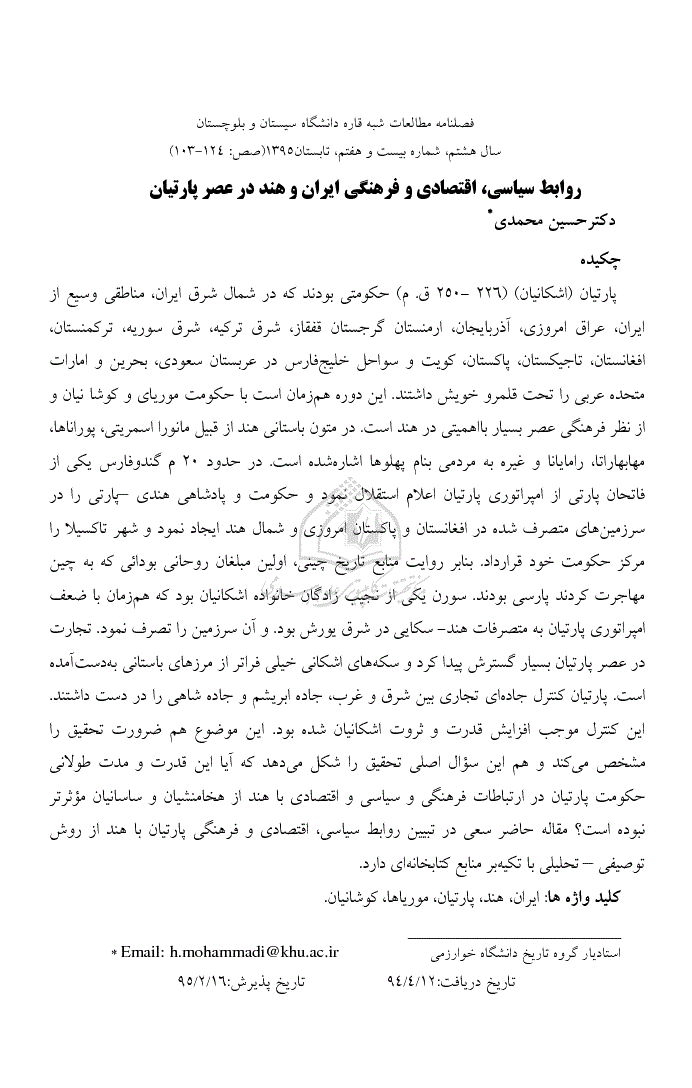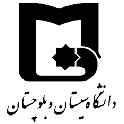چکیده:
پارتیان (اشکانیان) (۲۲۶ -۲۵۰ ق. م) حکومتی بودند که در شمال شرق ایران، مناطقی وسیع از ایران، عراق امروزی، آذربایجان، ارمنستان گرجستان قفقاز، شرق ترکیه، شرق سوریه، ترکمنستان، افغانستان، تاجیکستان، پاکستان، کویت و سواحل خلیج فارس در عربستان سعودی، بحرین و امارات متحده عربی را تحت قلمرو خویش داشتند. این دوره هم زمان است با حکومت موریای و کوشا نیان و از نظر فرهنگی عصر بسیار بااهمیتی در هند است. در متون باستانی هند از قبیل مانورا اسمریتی، پوراناها، مهابهاراتا، رامایانا و غیره به مردمی بنام پهلوها اشاره شده است. در حدود ۲۰ م گندوفارس یکی از فاتحان پارتی از امپراتوری پارتیان اعلام استقلال نمود و حکومت و پادشاهی هندی –پارتی را در سرزمین های متصرف شده در افغانستان و پاکستان امروزی و شمال هند ایجاد نمود و شهر تاکسیلارا مرکز حکومت خود قرارداد. بنابر روایت منابع تاریخ چینی، اولین مبلغان روحانی بودائی که به چین مهاجرت کردند پارسی بودند. سورن یکی از نجیب زادگان خانواده اشکانیان بود که هم زمان با ضعف امپراتوری پارتیان به متصرفات هند- سکایی در شرق یورش بود. و آن سرزمین را تصرف نمود. تجارت در عصر پارتیان بسیار گسترش پیدا کرد و سکه های اشکانی خیلی فراتر از مرزهای باستانی به دست آمده است. پارتیان کنترل جاده ای تجاری بین شرق و غرب، جاده ابریشم و جاده شاهی را در دست داشتند. این کنترل موجب افزایش قدرت و ثروت اشکانیان شده بود. این موضوع هم ضرورت تحقیق را مشخص می کند و هم این سوال اصلی تحقیق را شکل می دهد که آیا این قدرت و مدت طولانی حکومت پارتیان در ارتباطات فرهنگی و سیاسی و اقتصادی با هند از هخامنشیان و ساسانیان موثرتر نبوده است؟ مقاله حاضر سعی در تبیین روابط سیاسی، اقتصادی و فرهنگی پارتیان با هند از روش توصیفی – تحلیلی با تکیه بر منابع کتابخانه ای دارد.
Parthia (Persian: Ashkanian) (250 B.C. 226 A.D.)was a civilization situated in the northeast of modern Iran، but at its height covering all of Iran proper، as well as regions of the modern countries of Iraq، Azerbaijan، Armenia، Georgia، eastern Turkey، eastern Syria، Turkmenistan، Afghanistan، Tajikistan، Pakistan، Kuwait، the Persian Gulf coast of Saudi Arabia، Bahrain and the Unite Arab Emirates. This phase، contemporary to Mauryan and Kushan periods in India، is culturally very significant. It witnessed the fusion of Hellenic، Iranian and Buddhist arts. There was also the exchange of religious ideas as indicated by Kanishka’s coins.The Pahlavas are a people mentioned in ancient Indian texts like the Manu Smriti، various Puranas، Ramayana، Mahabharata، etc. Around 20 A.D. Gondophares، one of the Parthian conquerors، declared his independence from the Parthian empire and established the Indo-Parthian Kingdom in the conquered territories. in an area covering today's Afghanistan، Pakistan and parts of Northern India. The Kingdom's capital was Taxila (Pakistan) According to Chinese historical sources، the first missionary Buddhist monks to travel to China were Parsi scholars،The Parthians of east Iran and Central Asian translated Sanskrit texts into Chinese. An- Shih-Kao was a Parthian prince who became a Buddhist monk.Following the weakening of the Parthian empire. the Suren، a noble Parthian family of Arsacid descent، started to make inroads into eastern territories that had been occupied by the Indo-Scythians. Trade developed greatly under the Parthians and many Parthian coins have been found beyond its ancient boundaries. Parthian control of the overland trade routes between east and west، the Silk Road and the Persian Royal Road. This control of trade was to be the foundation of Parthian wealth and power.This article tries to explain policy –economic and cultural relationship between Indo-Parthian by using descriptive-analytic methods supported by library documents and sources.
خلاصه ماشینی:
م با عبور از کوه هاي هندوکش در شرق افغانستان به هند حمله کرد و نزديک به يک سال با قبايل مختلف در مسير لشکرکشي اش يعني شمال پاکستان امروزي جنگيد (٢٠٠٢٥٧,Kulre )درراه تاکشيلا، اسکندر با مقابله ي شديد آشواکاس (Ashwakas) مواجه شد با اين وجود آن ها را شکست داد و با عبور از رودخانه ي سند (Indus) به تاکشيلا (takshila) رسيد.
پيشينه تحقيق در خصوص پيشينه تحقيق نيز بايد گفت که در اين موضوع هيچ کتابي تأليف نشده است و چندين مقاله مربوط به سال هاي بسيار دور در ارتباط با روابط ايران و هند عصر باستان نگاشته شده است .
مقالات تاراچند، ١٩٨٩، با عنوان روابط هند و ايران در مجله تحقيقات فارسي بياض ، علي اصغر حکمت ، در سال هاي ١٣٣٨ ه ش تحت عنوان روابط هند قديم و ايران باستان در مجله دانشکده ادبيات دانشگاه تهران و علاءالدين آذري در مجله بررسي هاي تاريخي تحت عنوان روابط ايران و هند و روابط ايران و جين در مجله بررسي هاي تاريخ و مطالعات و تحقيقات فرهنگي، ستاري در مجله هنر و مردم در سال هاي ١٣٤٨ با عنوان مقدمه اي بر هزار و يک شب و شوشتري تحت عنوان علايق فرهنگي آريايي هند و ايران در مجله آيينه هند، مجيد يکتايي در نشريه انجمن فرهنگ و ايران باستان در سال هاي ١٣٥٨ نفوذ فرهنگ و تمدن ايران در سرزمين هند و در منابع انگليسي همچون Thapliyal-Uma–Ojha -Majoumdar که توسط محققان هندي و با عنوان تأثير عوامل خارجي در هند به عنوان بخشي از بررسي تاريخ هند نگاشته شده است .

(پژوهیار,
,
,
)

